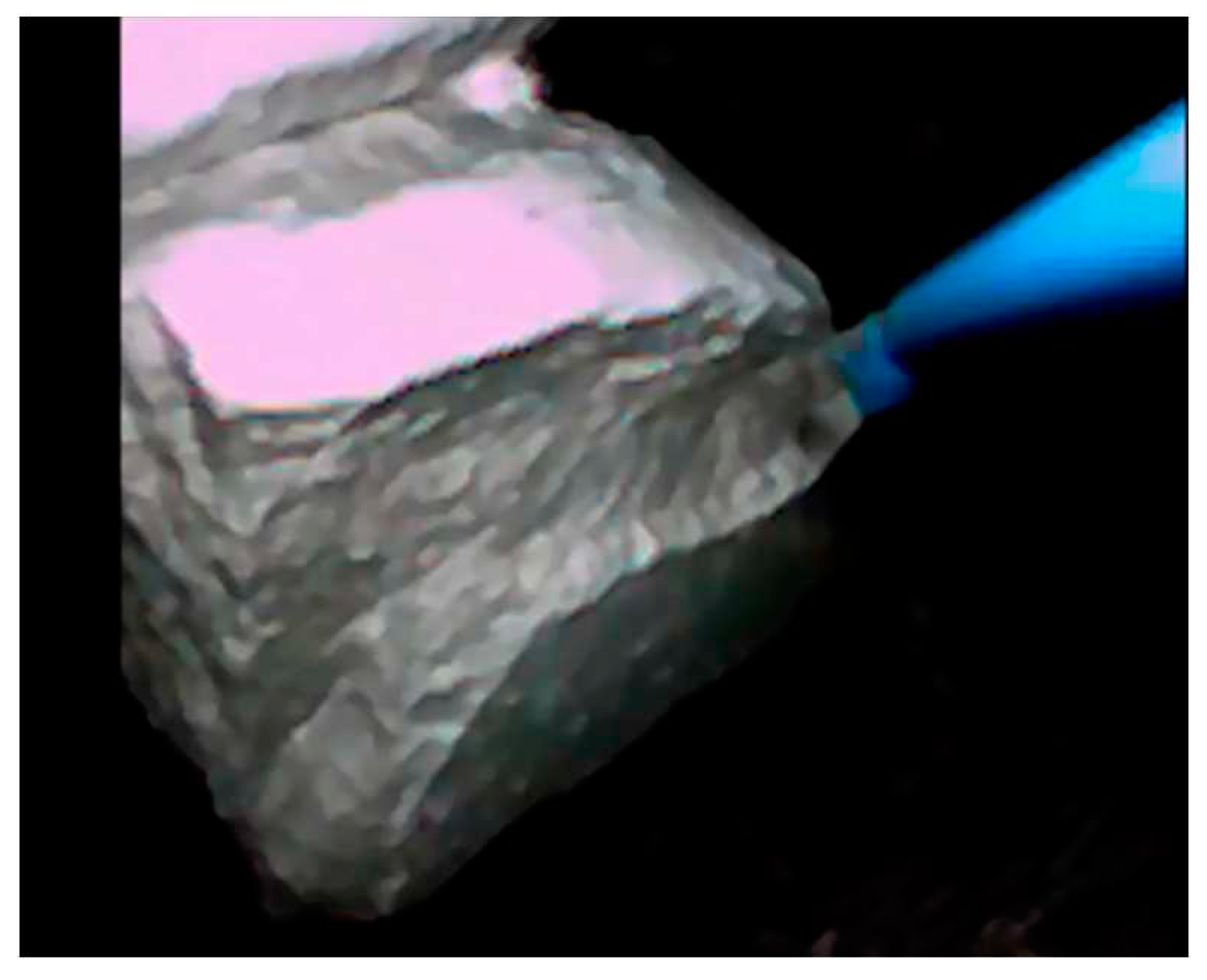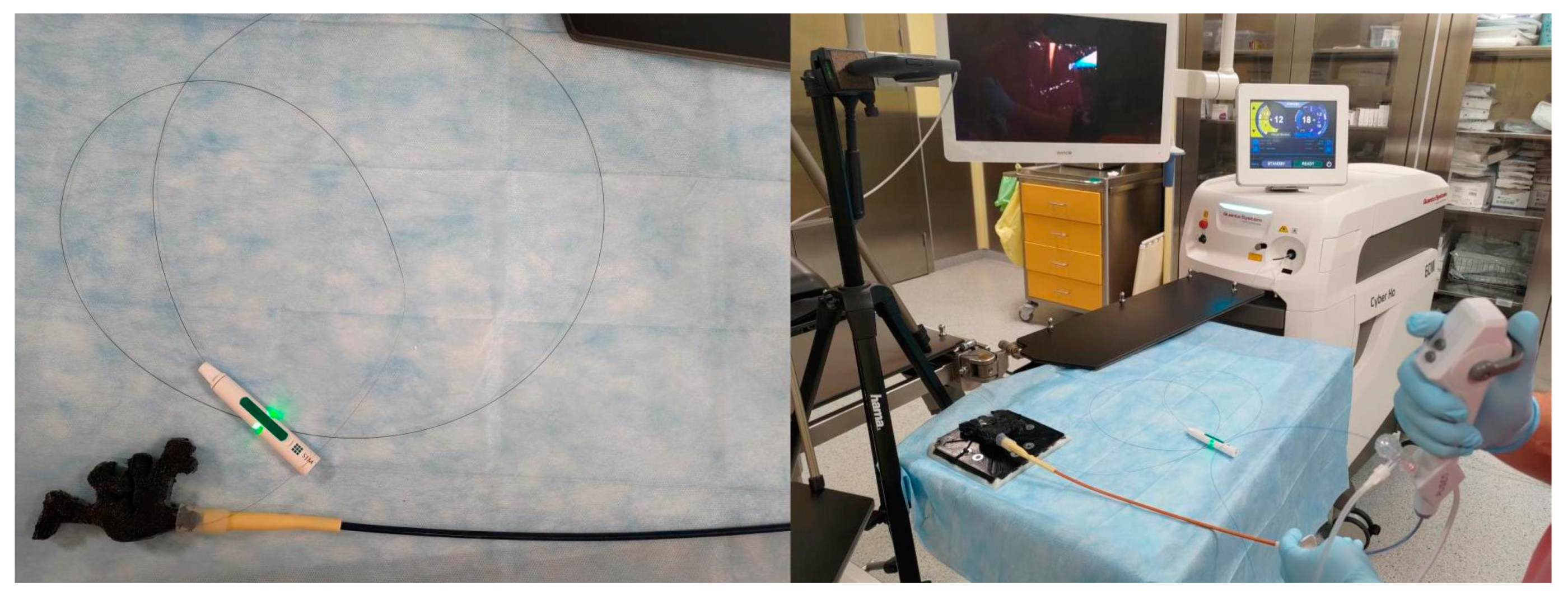Submitted:
09 October 2023
Posted:
10 October 2023
You are already at the latest version
Abstract
Keywords:
1. Introduction
2. Materials and Methods
2.1. The 3D printed renal pelvicalyceal model and stone development
2.2. Intrapelvic pressure measurement
2.3. Study design
2.4. Methodology
2.5. Statistical environment
2.6. Characteristic of the sample
3. Results
3.1. Study of group and parameter effects on IPP in the form of an ANCOVA model
| Parameter | Contrasts | The effect size | ||||||||
| Difference | 95% CI | SE | p | d | SE | 95% CI | ||||
| 12W15Hz 0.8J | 138.76 | [138.42, 139.09] | 0.17 | <0.001 | 2.18 | <0.01 | [2.18, 2.19] | |||
| 15W 15Hz 1.0J | 113.66 | [113.33, 113.99] | 0.17 | <0.001 | 1.79 | <0.01 | [1.78, 1.79] | |||
| 15W 50Hz 0.3J | 158.13 | [157.83, 158.42] | 0.15 | <0.001 | 2.49 | <0.01 | [2.48, 2.49] | |||
| 18W 15Hz 1.2J | 164.92 | [164.61, 165,64] | 0.16 | <0.001 | 2.59 | <0.01 | [2.59, 2.60] | |||
| 18W 30Hz 0.6J | 182.19 | [181.89, 182.50] | 0.16 | <0.001 | 2.86 | <0.01 | [2.86, 2.87] | |||
| 20W 10Hz 2.0J | 143.36 | [143.07, 143.65] | 0.15 | <0.001 | 2.25 | <0.01 | [2.25, 2.26] | |||
| 25W 10Hz 2.5J | 155.81 | [155.48, 156.15] | 0.17 | <0.001 | 2.45 | <0.01 | [2.44, 2.46] | |||
4. Discussion
5. Conclusions
Funding
Institutional Review Board Statement
Informed Consent Statement
Data Availability Statement
References
- Tokas T, Tzanaki E, Nagele U, Somani BK. Role of Intrarenal Pressure in Modern Day Endourology (Mini-PCNL and Flexible URS): a Systematic Review of Literature. Curr Urol Rep. Oct 08 2021;22(10):52. [CrossRef]
- Jung H, Osther PJ. Intraluminal pressure profiles during flexible ureterorenoscopy. Springerplus. 2015;4:373. [CrossRef]
- Boccafoschi C, Lugnani F. Intra-renal reflux. Urol Res. 1985;13(5):253-8. [CrossRef]
- Thomsen HS, Dorph S, Larsen S, Talner LB. Intrarenal backflow and renal perfusion during increased intrapelvic pressure in excised porcine kidneys. Acta Radiol Diagn (Stockh). 1983;24(4):327-36. [CrossRef]
- Pauchard F, Ventimiglia E, Corrales M, Traxer O. A Practical Guide for Intra-Renal Temperature and Pressure Management during Rirs: What Is the Evidence Telling Us. J Clin Med. Jun 15 2022;11(12). [CrossRef]
- Doizi S, Letendre J, Cloutier J, Ploumidis A, Traxer O. Continuous monitoring of intrapelvic pressure during flexible ureteroscopy using a sensor wire: a pilot study. Article. World Journal of Urology. Feb 2021;39(2):555-561. [CrossRef]
- Croghan SM, Skolarikos A, Jack GS, et al. Upper urinary tract pressures in endourology: a systematic review of range, variables and implications. BJU Int. Mar 2023;131(3):267-279. [CrossRef]
- Auge BK, Pietrow PK, Lallas CD, Raj GV, Santa-Cruz RW, Preminger GM. Ureteral access sheath provides protection against elevated renal pressures during routine flexible ureteroscopic stone manipulation. J Endourol. Feb 2004;18(1):33-6. [CrossRef]
- Sierra A, Corrales M, Kolvatzis M, Doizi S, Traxer O. Real Time Intrarenal Pressure Control during Flexible Ureterorrenscopy Using a Vascular PressureWire: Pilot Study. J Clin Med. Dec 24 2022;12(1). [CrossRef]
- Sorokin I, Cardona-Grau DK, Rehfuss A, et al. Stone volume is best predictor of operative time required in retrograde intrarenal surgery for renal calculi: implications for surgical planning and quality improvement. Article. Urolithiasis. Nov 2016;44(6):545-550. [CrossRef]
- Tokas T, Herrmann TRW, Skolarikos A, Nagele U, (T.R.U.S.T.)-Group TaRiUSaT. Pressure matters: intrarenal pressures during normal and pathological conditions, and impact of increased values to renal physiology. World J Urol. Jan 2019;37(1):125-131. [CrossRef]
- Osther PJS. Risks of flexible ureterorenoscopy: pathophysiology and prevention. Urolithiasis. Feb 2018;46(1):59-67. [CrossRef]
- Schwalb DM, Eshghi M, Davidian M, Franco I. Morphological and physiological changes in the urinary tract associated with ureteral dilation and ureteropyeloscopy: an experimental study. J Urol. Jun 1993;149(6):1576-85. [CrossRef]
- Takayasu H, Aso Y. Recent development for pyeloureteroscopy: guide tube method for its introduction into the ureter. J Urol. Aug 1974;112(2):176-8. [CrossRef]
- Noureldin YA, Kallidonis P, Ntasiotis P, Adamou C, Zazas E, Liatsikos EN. The Effect of Irrigation Power and Ureteral Access Sheath Diameter on the Maximal Intra-Pelvic Pressure During Ureteroscopy:. J Endourol. Sep 2019;33(9):725-729. [CrossRef]
- Monga M, Bodie J, Ercole B. Is there a role for small-diameter ureteral access sheaths? Impact on irrigant flow and intrapelvic pressures. Urology. Sep 2004;64(3):439-41; discussion 441-2. [CrossRef]
- Fang L, Xie G, Zheng Z, et al. The Effect of Ratio of Endoscope-Sheath Diameter on Intrapelvic Pressure During Flexible Ureteroscopic Lasertripsy. J Endourol. Feb 2019;33(2):132-139. [CrossRef]
- MacCraith E, Yap LC, Elamin M, Patterson K, Brady CM, Hennessey DB. Evaluation of the Impact of Ureteroscope, Access Sheath, and Irrigation System Selection on Intrarenal Pressures in a Porcine Kidney Model. J Endourol. Apr 2021;35(4):512-517. [CrossRef]




| group | n | cmH2O | |||
| M (SD) | Mdn (Q1, Q3) | Min | Max | ||
| 10/12Fr | 2 957 775 | 175.0 (83.4) | 172.0 (114.0, 228.0) | 6.8 | 461.7 |
| 12/14Fr | 1 922 476 | 22.6 (10.9) | 21.3 (13.9, 29.0) | 6.8 | 106.5 |
| Parameter, W/Hz/J | group | n | cmH2O | |||
| M (SD) | Mdn (Q1, Q3) | Min | Max | |||
| 12/15/0.8 | 10/12Fr | 497 026 | 157.1 (78.8) | 151.0 (99.7, 208.0) | 6.8 | 414.7 |
| 12/14Fr | 190 023 | 18.3 (7.6) | 17.5(12.9, 22.8) | 6.8 | 86.9 | |
| 15/15/1.0 | 10/12Fr | 266 082 | 133.3 (63.4) | 134.9 (91.6, 175.2) | 6.8 | 332.4 |
| 12/14Fr | 297 294 | 19.7 (7.15) | 19.9 (14.0, 24.5) | 6.8 | 60.4 | |
| 15/50/0.3 | 10/12Fr | 755 398 | 182.1 (73.0) | 183.4 (136.2, 225.5) | 6.8 | 411.9 |
| 12/14Fr | 234 420 | 24.0 (11.9) | 24.1 (12.6, 32.2) | 6.8 | 94.4 | |
| 18/15/1.2 | 10/12Fr | 396 417 | 188.0 (74.9) | 193.2 (135.7, 242.0) | 6.8 | 461.7 |
| 12/14Fr | 272 102 | 23.0 (9.5) | 23.7 (14.8, 29.9) | 6.8 | 87.7 | |
| 18/30/0.6 | 10/12Fr | 314 585 | 204.8 (97.5) | 204.6 (125.9, 275.3) | 6.8 | 415.5 |
| 12/14Fr | 351 461 | 22.6 (11.5) | 20.7 (13.3, 29.9) | 6.8 | 106.4 | |
| 20/10/2.0 | 10/12Fr | 400 407 | 167.1(77.3) | 163.1 (108.1, 217.9) | 6.8 | 414.8 |
| 12/14Fr | 339 951 | 23.8 (11.5) | 22.7 (14.6, 31.00) | 6.8 | 96.1 | |
| 25/10/2.5 | 10/12Fr | 327 860 | 181.6 (106.8) | 168.7 (94.4, 253.1) | 6.8 | 414.6 |
| 12/14Fr | 237 225 | 25.8 (13.8) | 23.0 (15.1, 34.9) | 6.8 | 96.0 | |
| group | IPP, cmH2O | ||
| EMMs | SE | 95%CI | |
| 10/12Fr | 173.43 | 0.04 | [173.36, 173.51] |
| 12/14Fr | 22.46 | 0.05 | [22.37, 22.55] |
| parameter | group | IPP, cmH2O | ||
| EMMs | SE | 95%CI | ||
| 12W15Hz 0.8J | 10F/12F | 157.08 | 0.09 | [156.91, 157.26] |
| 12/14Fr | 18.33 | 0.15 | [18.04, 18.61] | |
| 15W 15Hz 1.0J | 10/12Fr | 133.34 | 0.12 | [133.10, 133.59] |
| 12/14Fr | 19.68 | 0.12 | [19.46, 19.91] | |
| 15W 50Hz 0.3J | 10/12Fr | 182.11 | 0.07 | [181.97, 182.25] |
| 12/14Fr | 23.98 | 0.13 | [23.73, 24.24] | |
| 18W 15Hz 1.2J | 10/12Fr | 187.95 | 0.10 | [187.75, 188.15] |
| 12/14Fr | 23.03 | 0.12 | [22.79, 23.27] | |
| 18W 30Hz 0.6J | 10/12Fr | 204.80 | 0.11 | [204.57, 205.02] |
| 12/14Fr | 22.60 | 0.11 | [22.39, 22.81] | |
| 20W 10Hz 2.0J | 10/12Fr | 167.11 | 0.10 | [166.92, 167.31] |
| 12/14Fr | 23.76 | 0.11 | [23.54, 23.97] | |
| 25W 10Hz 2.5J | 10/12Fr | 181.63 | 0.11 | [181.42, 181.85] |
| 12/14Fr | 25.82 | 0.13 | [25.57, 26.08] | |
Disclaimer/Publisher’s Note: The statements, opinions and data contained in all publications are solely those of the individual author(s) and contributor(s) and not of MDPI and/or the editor(s). MDPI and/or the editor(s) disclaim responsibility for any injury to people or property resulting from any ideas, methods, instructions or products referred to in the content. |
© 2023 by the authors. Licensee MDPI, Basel, Switzerland. This article is an open access article distributed under the terms and conditions of the Creative Commons Attribution (CC BY) license (http://creativecommons.org/licenses/by/4.0/).





